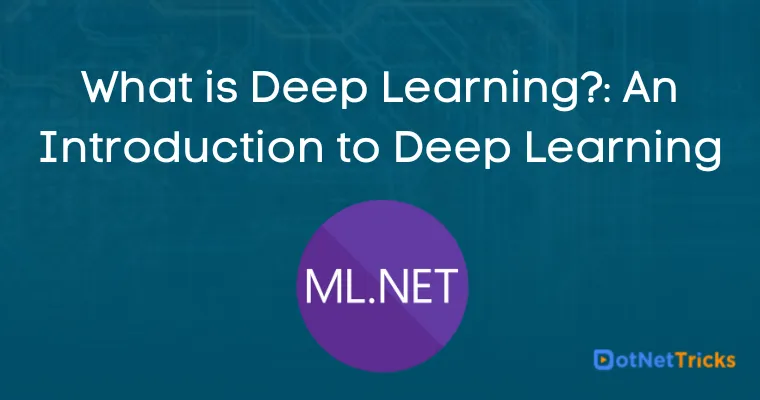25
apr.What is Deep Learning?: An Introduction to Deep Learning
In the recent few years, Artificial Intelligence or AI has become one of the most discussed and popular subjects in the IT industry. Nowadays, a large number of articles, papers, documentation related to Machine learning, Deep Learning and AI are written and published even by the Non-Technology related publications. These technologies promised a future of intelligent chatbots, self-driving card, and virtual assistants, etc. So, as an IT developer, we need to understand the current trend of the Software development Industry related to Artificial Intelligence or AI. So, Deep Learning is basically is a subset of Machine Learning technique which helps to teach computers to do what comes naturally to humans. Deep learning is the key technical process behind the driverless cards, enabling them to recognize a stop signal in the road or identified a pedestrian from a lamppost. In the case of Deep Learning, a computer data model learns to perform classification tasks directly either from images or text or sound. Deep learning models can be achieved by state-of-the-art accuracy. These models are trained by using a large set of labeled data samples and neural network architectures which must contain many layers.
What is Deep Learning?
In the real world, Artificial Intelligence or AI is involved when a computer or machine can perform a task which requires human intelligence to complete that task. This can be achieved by Machine learning, where machines can learn by the past data samples and experience and gain the skill without human involvement. Deep Learning is basically a subset of machine learning where artificial neural networks, algorithms developed by the human brain can be learned from the least amount of the data model. So, the deep learning algorithm can perform a task repeatedly, each time it will improve a little bit the output result.
So, Deep Learning is an artificial intelligence function which intimates the workings of human intelligence in processing the data and also creating patterns for use in decision making. That we already said that Deep Learning is a subset of machine learning in the Artifical Intelligence which always capable of learning unsupervised from data.

Machine Learning always try to solve real-world problems. Machine learning always designed in such a way that it can provide human decision-making capabilities with the help of Artificial Intelligence. So, Deep learning is the most Machine Learning supported tools and techniques which are the key narrow subsets which focus only on the respective real-world based problem solutions. So, we can apply deep learning to solve any problem which requires human intelligence or AI. Any deep learning network always consists of three types of layers –
Input Layer
Hidden Layer
Output Layer
So, in a simple word, Deep learning is one of the newest terms in the field of Machine learnings and with the help of this, we can implement machine learnings.
How Deep Learning Works..
Deep Learning is mainly based on Artificial Neutral Network (ANN). ANN networks are old enough as AI. The main purpose of these networks is to make computers as a smart device just like the human brain. ANN is mainly the network of neurons connected with Synopses. A neuron is just a unit of calculation and it can be a physical device or an algorithm. On the other hand, a synposes act just like biological counterparts. It is normally connecting tissue with a caveat. It means it normally utilizes the algorithm which performs the calculation by neuron before going to the next. So, the neurons and synapses build a connectionist system and these systems generate the output by considering some examples without any program. Every ANN always has an input layer, a hidden layer, and an output layer. The main magical activities happened within the hidden layer. In the case of deep learning, there is always a chance to contain multiple hidden layers.
In general, every Deep Learning system works in a two steps methodology or phase. First one is training and the second one is inferring. In the training phases, the ANN networks are exposed to a lot of data. Once the training has been done, ANNs use inferring to predict much more educated and calculated guess on new, previously unexposed and release world data.
Deep Learning vs. Machine Learning
Machine Learning is one of the most common and popular AI techniques for process big volume of data along with a self-adaptive algorithm for better analysis of data. Whereas Deep Learning, is a subset of machine learning and it always utilizes a hierarchical level of artificial neural networks to complete the process of machine learning. The artificial neural networks are built just like the human brain where neuron nodes are connected together like a web net. The basic key difference between Machine Learnings and Deep Learnings are below :
Performance is the main key difference between these two techniques algorithms. Deep learnings algorithms are not working properly in case of a small volume of data. Since deep learning always requires a large volume of data to understand the algorithm properly.
Normally, Deep Learnings depends on the high-end machines whereas Machine Learning or Traditional learnings is normally based on low-end machines.
Normally, Deep Learnings always takes more time to train the input data as compared to Machine Learning.
Machine Learning is always used in many cased in the IT Industry. Whereas in the case of Deep Learning, users think 10 times to start to integrate this with their systems.
3 Reasons to go for Deep Learning
If we want to use Deep Learning, below are the key benefits or reason to use Deep Learning.
Deep Learning techniques is much more cost-effective and time saver process.
For every case of Deep Learning, we can maintain the quality of the development and also can maintain the quantity of the developments.
In the case of deep learning, It always provides us much more facility in case of the deep learning process.
Real-Life Use Cases for Deep Learning
Deep Learning always provides excellent performance in identifying patterns within unstructured data like image, text, sound, video, etc. Some use cases of the Deep Learnings are :
Voice Recognition
Log Analysis
Enterprise Resouce Planning
Facial Recognition
Motion Detection
Real-time threat detection.
Limitations of Deep Learning
Deep Learning is very much powerful to solve the classified problem. But still, deep learning has some limitations in respects of the classified problem solution. Some of the limitations are :
One of the major limitations in Deep Learnings is Lack of Common sense. It is the ability to make decisions even with limited experience. The deep-learning algorithm can not take conclusive decisions in the cross-domain area.
It is unable to learn from limited examples. Since its accuracy depends on the training data models. That’s why it is not capable to solve any problem which dynamically changes.
It is much less powerful beyond the classified problem.
Summary
So, deep learning is one of the most powerful of Artificial Intelligence. But, in spite of its benefits and usefulness, it has many limitations. We discuss the basic idea of deep learning along with a comparison with Machine learning in these articles. Also, we have discussed some mostly used cases of deep learning and some of its limitations.
Take our free skill tests to evaluate your skill!

In less than 5 minutes, with our skill test, you can identify your knowledge gaps and strengths.







